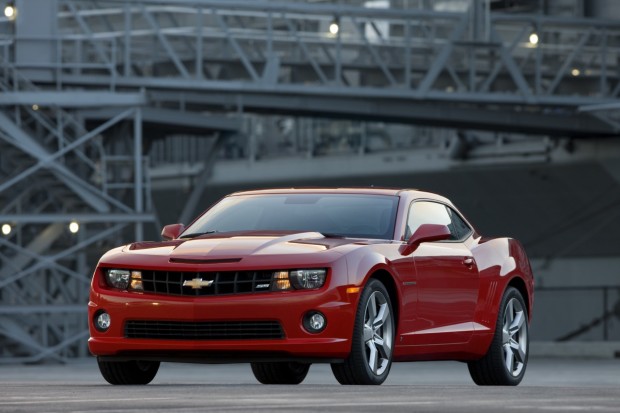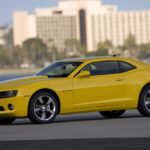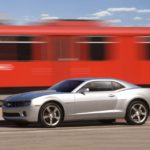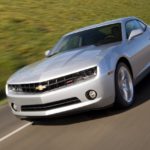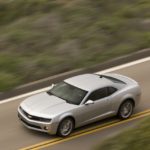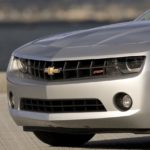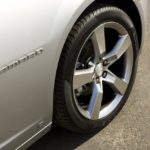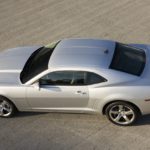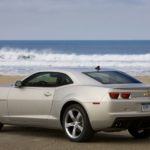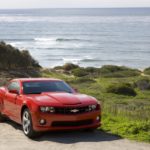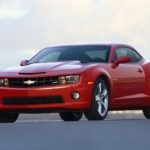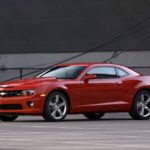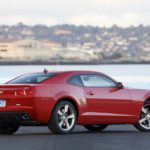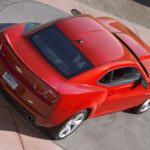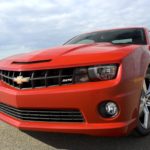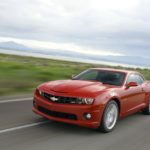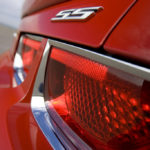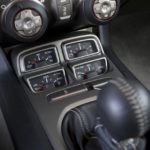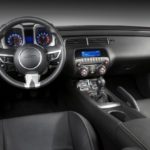Der neue Camaro ist da und seine kompletten technischen Daten inkl. Verbrauch
Seit dem 16. März 2008 ist es endlich soweit, denn gestern liefen die Produktionsbänder offiziell, für den Chevrolet Camaro an. Dies hat General Motors auch zum Anlass gegeben uns die neuesten technischen Daten zukommen zu lassen. Auch dabei der Verbrauch und die harten Fakten des Sprints von 0 auf 100 km/h. Fangen wir also gleich mal mit dem kleinen Camaro an, welcher mit einem 3,6L V6 Motor eine Leistung von 304 PS auf die Straße bringt und laut GM einen Verbrauch von 29 Meilen pro Gallone hat, sprich 8,1L auf 100 km, wohlgemerkt auf Überlandfahrten. In der Stadt muss man mit 13L pro 100 km (6-Gang Automatik) bzw. 13,8L (6-Gang Schalter) rechnen. Bei dem stärkeren V8 Model sind es hingegen 14,6L im Stadtverkehr und 9,4L auf der Landstraße, pro 100km. Das sind doch beachtlich niedrige Werte, wenn man dafür in nur 4,2 Sek von 0-100 km/h beschleunigen könnte und man dies alles für einen relativ niedriegen Preis erhalten kann. Die drei Muscle cars hier einmal im direkten Vergleich.
| Muscle Cars: Verbrauchswerte – Stadt/Überland | |||
|---|---|---|---|
| 2010 Chevy Camaro | 2010 Ford Mustang* | 2010 Dodge Challenger | |
| V6** |
13L/8,1L | 14,6L/9,8L | 13,8L/9,4L |
| V8** |
14,7L/9,4L | 13,8L/10,2L | 18L/12,4L |
| Manuel |
6-Gang | 5-Gang | 6-Gang |
| Auto |
6-Gang | 5-Gang | 4 und 5-Gang |
*2010 Ford Mustang sind bisherige Schätzungen
**Angaben für die stärkste Ausführung mit Automatikgetriebe
PRESS RELEASE
2010 CHEVY CAMARO’S PERFORMANCE BLENDS HORSEPOWER WITH EFFICIENCY
DETROIT – When it comes to performance, the 2010 Camaro delivers in unexpected ways. An advanced 3.6L direct-injected V-6 with variable valve timing is standard on LS and LT models. It offers power and efficiency, with 304 horsepower (227 kW) and EPA-rated 29 mpg in highway driving.
The performance-oriented Camaro SS offers a pair of 6.2L V-8s, including one with Active Fuel Management that helps improve fuel economy by shutting down four cylinders during certain light-load driving conditions. That model delivers 25 mpg in EPA-rated highway fuel economy.
Indeed, the surprising fuel economy of the new Camaro enhances the driving experience. LS and LT models are EPA-rated at 18 mpg in the city and 29 on the highway with an automatic transmission; and 17 city and 29 highway with the manual transmission. Camaro SS with an automatic is rated at 16 city and 25 highway; and 16 city/24 highway with the manual transmission. Notably, none of Camaro’s models is subject to federal gas guzzler taxes.
For comparison, the more expensive 2009 Dodge Challenger SRT8 offers comparable horsepower to the Camaro SS with the manual transmission – 425 (317 kW) vs. 426 (318 kW) – and is EPA-rated at 14 city and 22 highway. When automatic-equipped models are compared, the Camaro wins again, with the Challenger SRT8 rated at 13 city and 19 highway.
All of Camaro’s engines channel their power to a responsive chassis that features independent front and rear suspensions, large, four-wheel-disc brake systems with standard ABS and GM’s StabiliTrak electronic stability control system.
3.6L direct injection V-6
Camaro’s 3.6L direct injection (DI) V-6 delivers more power through increased efficiency, while maintaining fuel economy and lowering emissions – including a 25-percent drop in cold-start hydrocarbon emissions. Direct injection optimizes fuel delivery to the combustion chamber by introducing fuel closer to the combustion chamber. The fuel injectors are located beneath the intake ports and fuel is injected directly into the cylinder. The result is better efficiency in the combustion process leading to increased fuel efficiency at part and full throttle.
The 3.6L DI engine produces 304 horsepower (227 kW) at 5,900 rpm and 273 lb.-ft. of torque (370 Nm) at 5,200 rpm. Its 60-degree cylinder block and cylinder heads are cast aluminum to help reduce mass. A forged steel crankshaft provides optimal strength in the bottom end. The cylinder heads include four valves per cylinder, with a dual overhead camshaft design incorporating infinitely variable cam phasing.
A full dual exhaust system, with dual catalytic converters, helps reduce back pressure for optimum power. It also helps the engine reach operating temperature quicker to help burn off cold-start emissions. And despite a compression ratio of 11.3:1, the 3.6L DI engine is designed to run on regular gas.
Camaro SS’s 6.2L powertrains
Two 6.2L V-8 engines are offered in the Camaro SS, including the new L99 on automatic-equipped vehicles and the LS3 on manual-equipped models. Both engines are derived from the LS3 that debuted on the 2008 Corvette.
The 90-degree V-8 includes an aluminum block (with cast iron cylinder liners) and aluminum cylinder heads. The bottom end of the engine includes a new structural cast aluminum oil pan, with an oil capacity of 8.9 quarts (8.5 liters), while the two-valve cylinder head design is based on race-proven airflow dynamics. The intake valves measure 2.16 inches (55 mm) and exhaust valves are 1.60 inches (40.5 mm) in diameter.
The 6.2L engines also use a roller lifter-style camshaft with 5-percent greater intake-side valve lift than the Corvette’s LS3. It manages airflow that is channeled through an acoustically tuned intake manifold with a composite design that reduces runner-to-runner variation. The throttle bore diameter is 90 mm.
Horsepower for the L99 is 400 (298 kW) at 5,900 rpm and torque is 410 lb.-ft. (556 Nm) at 4,300 rpm. The LS3 develops 426 horsepower (318 kW) at 5,900 rpm and 420 lb.-ft. (569 Nm) at 4,600 rpm (all numbers are SAE certified). Output on the L99 is lower than the LS3 because of a slighter lower compression ratio (10.4:1 vs. 10.7:1) and design features of the Active Fuel Management System. The L99 is paired exclusively with an automatic transmission.
As with the 3.6L models, the SS models employ a full dual exhaust system, with two catalytic converters to reduce back pressure.
Transmissions
All Camaro models can be equipped with either a six-speed manual or six-speed automatic transmission. The availability of a six-speed automatic transmission is a first for Camaro.
Standard with the 3.6L engine is the Aisin AY6 six-speed manual. It features lower shift effort and shorter throws for easier shifting and „fun-to-drive“ characteristics. A hydraulic clutch and self-adjusting mechanism eliminates the need for adjustments throughout the lifespan of the transmission.
The Hydra-Matic 6L50 six-speed automatic is optional with 3.6L-equipped models. It has an aggressive 4.07:1 first gear ratio that delivers strong launches, but also provides tall overdrive ratios that decrease engine rpm and provide better fuel efficiency. The 6L50 also includes driver shift control, with the driver taking control via paddle shifts located on the steering wheel after selecting the „M“ mode on the console-mounted shifter.
Performance Algorithm Shifting (PAS) is included with the 6L50. It lets the electronic transmission controller override the automatic gear selection during high lateral acceleration maneuvers.
On SS models, the new Tremec TR 6060 six-speed manual is paired with the LS3. It is designed to handle the high torque characteristics of the engine, while providing shorter throws, smoother gear synchronization and greater overall shift feel with little or no vibration. Its specs include a solid 290 mm flywheel and single-plate clutch. The final drive ratio for LS3 vehicles is 3.45:1.
The highest-capacity automatic ever in a GM passenger car, the Hydra-Matic 6L80 six-speed automatic, is matched with the L99 engine. Like the 6L50 transmission, it features driver shift control and PAS. The final drive ratio on all automatic-equipped Camaro models is 3.27:1.
2010 CHEVROLET CAMARO SPECIFICATIONS
Overview
|
Models: |
Chevrolet Camaro LS, LT and SS |
|
Body style / driveline: |
four-passenger, front-engine, rear-drive coupe |
|
Construction: |
unitized body frame, one- and two-sided galvanized steel |
|
EPA vehicle class: |
coupe |
|
Manufacturing location: |
Oshawa, Ontario, Canada |
|
Key competitors: |
Dodge Challenger, Ford Mustang, Nissan 370Z |
Engines
|
3.6L V-6 DI VVT (LLT) |
6.2L V-8 (LS3, L99) |
|
|
Application: |
LS, LT |
SS |
|
Type: |
3.6L V-6 |
6.2L V-8 |
|
Displacement (cu in / cc): |
217 / 3564 |
376 / 6162 |
|
Bore & stroke (in / mm): |
3.70 x 3.37 / 94 x 85.6 |
4.06 x 3.62 / 103.25 x 92 |
|
Block material: |
cast aluminum w/ cast-in-place iron bore liners |
cast aluminum w/ cast-in-place iron bore liners |
|
Cylinder head material: |
aluminum |
aluminum |
|
Valvetrain: |
dual overhead camshafts, four valves per cylinder, continuously variable valve timing |
valve-in-head; two valves per cylinder; roller lifters; Active Fuel Management (L99) |
|
Ignition system: |
electronic individual coil-on-plug; individual cylinder knock control and extended-life platinum-tipped spark plugs |
high-energy distributorless ignition; solid state direct-fire ignition w/ coil near plug and integrated ignition |
|
Fuel delivery: |
direct high-pressure fuel injection |
returnless, multi-port fuel injection |
|
Compression ratio: |
11.3:1 |
10.7:1 (LS3); 10.4:1 (L99) |
|
Horsepower (hp / kW @ rpm): |
304 / 227 @ 6400 |
426 / 318 @ 5900 (LS3) |
|
Torque (lb-ft / Nm @ rpm): |
273 / 370 @ 5200* |
420 / 569 @ 4600 (LS3)* |
|
Recommended fuel: |
regular unleaded |
premium recommended |
|
Maximum engine speed (rpm): |
7000 |
6000 (L99) |
|
Emissions controls: |
evaporative system, close-coupled catalytic converter, equal-length exhaust, single underfloor catalytic converter, positive crankcase ventilation, intake and exhaust cam phasers, electronic throttle control |
evaporative system, close-coupled catalytic converters, positive crankcase ventilation, electronic throttle control |
|
Estimated fuel economy |
18 / 29 – auto |
16 / 25 – auto |
Transmissions
|
Hydra-Matic 6L50 six-speed automatic (LS, LT) w/ TAPshift |
Hydra-Matic 6L80 six-speed automatic (SS) w/ TAPshift |
Aisin AY6 six-speed manual (LS, LT) |
Tremec TR6060 six-speed manual (SS) |
|
|
Gear ratios (:1): |
||||
|
First: |
4.07 |
4.03 |
4.48 |
3.01 |
|
Second: |
2.37 |
2.36 |
2.58 |
2.07 |
|
Third: |
1.55 |
1.53 |
1.63 |
1.43 |
|
Fourth: |
1.16 |
1.15 |
1.19 |
1.00 |
|
Fifth: |
0.85 |
0.85 |
1.00 |
0.84 |
|
Sixth: |
0.67 |
0.67 |
0.75 |
0.57 |
|
Reverse: |
3.06 |
3.06 |
3.67 |
3.28 |
|
Final drive ratio: |
3.27 |
3.27 |
3.27 |
3.45 |
Chassis/Suspension
|
Front: |
double-ball-joint, multi-link strut; direct-acting stabilizer bar; progressive-rate coil springs; fully adjustable camber, caster and toe |
|
Rear: |
4.5-link independent; progressive-rate coil springs over shocks; stabilizer bar; fully adjustable camber and toe |
|
Steering type: |
variable-ratio rack-and-pinion |
|
Steering ratio: |
16.1:1 |
|
Steering wheel turns, lock-to-lock: |
2.5 |
|
Turning circle, curb-to-curb (ft / m): |
37.7/11.5 |
Brakes
|
Type: |
four-wheel disc w/ ABS; ventilated front and rear rotors; single-piston front calipers and single-piston alloy rear calipers (LS, LT); four-piston fixed Brembo aluminum front and rear calipers (SS) |
|
Rotor diameter, front (in / mm): |
LS, LT: 12.64 / 321 |
|
Rotor diameter, rear (in / mm): |
LS, LT: 12.4 / 315 |
|
Rotor thickness, front (in / mm): |
LS, LT: 1.18 / 30 |
|
Rotor thickness, rear (in / mm): |
LS, LT: 0.9 / 23 |
Wheels/Tires
|
LS |
LT |
SS |
|
|
Wheel size and type: |
18 x 7.5-inch steel |
18 x 7.5-inch aluminum 19 x 8-inch aluminum |
20 x 8-inch aluminum (front) |
|
Tires: |
P245/55R18 all-season |
P245/55R18 all-season P245/50R19 all-season |
P245/45ZR20 summer (front) |
Dimensions
Exterior
|
Wheelbase (in / mm): |
112.3 / 2852 |
|
Overall length (in / mm): |
190.4 / 4836 |
|
Overall width (in / mm): |
75.5 / 1918 |
|
Overall height (in / mm): |
54.2 / 1376 |
|
Track, front (in / mm): |
63.7 / 1618 |
|
Track, rear (in / mm): |
64.1 / 1628 (LS, LT) |
|
Curb weight (lb / kg): |
3769 / 1713 – LS w/ automatic |
|
Weight balance (% front / rear): |
52 / 48 |
|
Coefficient of drag: |
0.37 (LS, LT); 0.35 (SS) |
Interior
|
Seating capacity (front / rear): |
2 / 2 |
|
Headroom (in / mm): |
front: 37.4 / 950 |
|
Legroom (in / mm): |
front: 42.4 / 1077 |
|
Shoulder room (in / mm): |
front: 56.9 / 1444 |
Capacities
|
Cargo volume (cu ft / L): |
11.3 / 320 |
|
Fuel tank (gal / L): |
19 / 71.9 |
|
Engine oil (qt / L): |
3.6L: 7.6 / 7.2 |
*SAE certified.
Note: Information shown is current at time of publication.
[Source: General Motors/autoblog]
Leave a comment

